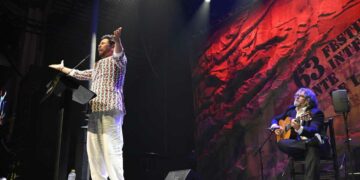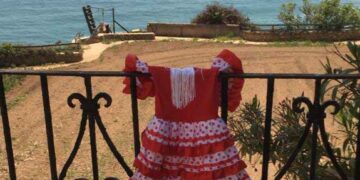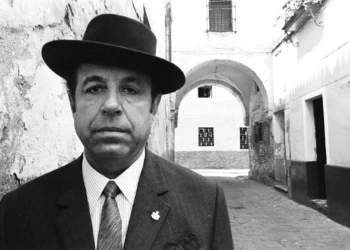|
XV FESTIVAL DE JEREZ |
|
Text: Estela Zatania Voice: Miguel Poveda. Cante: Carmen Grilo, Esperanza García de Coria, Miguel Lavi. Guitar: Juan Gómez “Chicuelo”, Jesús Guerrero. Piano: Joan Albert Amargós. Percussion: Paquito González. Palmas: Carlos Grilo, Luis Cantarote. Dance: Laura Rozalén. Original Idea, music director and selection of repertoire: Miguel Poveda, Rafael Estévez, Nani Paños. Saturday, March 5th was the beginning of the second half of the Festival de Jerez. For the show “Historias de Viva Voz” it wasn’t necessary to hand out free tickets in order to be able to boast of a “full house”. In fact, the Villamarta theater was jumping with excitement, you could feel it in the air, there were many people who seemed never to have cared much about flamenco before, and in fact, two additional performances had to be programmed for later in the month in order to accommodate the demand: everyone wants to see and hear the man from Catalonia. That’s how it goes with Miguel Poveda, flamenco singer, and social phenomenon, holder of the coveted Lámpara Minera of 1993 and Spain’s National Music prize of 2007. Aside from his artistic capacity and charisma, the secret to his extraordinary popularity may be due to something more subtle. In recent decades we’ve seen a growing division between followers of gypsy flamenco and non-gypsy, a circumstance that does nothing good for the genre, because racism is always a bad counsellor. But along comes Miguel Poveda, neither gypsy nor non-gypsy nor anything that fits any kind of mold. To declare oneself a follower of his doesn’t represent choosing up sides, and furthermore, the man commands a repertoire that covers all the cantes, in addition to Spanish lyrical song, Argentine tango and Catalonian poetry. He’s not easily pigeon-holed.
Some people complained that the show was pared down to include the only biggest crowd-pleasers, and little real flamenco was offered. But if you consider the objective was to paint a portrait of the history of flamenco singing of the last century, the fact is that popular music had an important presence, in addition to the fact that the show included tonás, pregón, toná liviana, cantiñas, polo, soleá apolá, peteneras, malagueña, jabera, verdial, fandango de Lucena, bulerías, romance and various bits and pieces of other cantes. Having thus met his obligations, I for one am happy to accept his (well-done and entertaining) imitations and evocations of Chacón, Caracol, Marchena, Valderrama, Miguel de Molina, Porrinas, Mairena, Morente, Bambino and others. It’s easy to call it “cheap”, but who else could have done a better job of summarizing the last hundred years of cante in just two hours? Poveda had words of praise for Enrique Morente, an adaptation of La Leyenda del Tiempo, two female voices to evoke the cante of Utrera and the very interesting Jerez singer Miguel Lavi, a diamond in the rough. Also worthy of mention is the fact that Poveda has perfected a dance style that credibly adorns his festive cante, and a lot of flamencos from the “right” families would love to move that elegantly in compás. In addition to the star of the show, there were three singers, two guitarists, one dancer, one pianist, one percussion person and two to play palmas, and that was all Miguel Poveda needed to drive the audience wild and remind everyone that no one owns flamenco because it belongs to each and every one of us. |




 “Historias de Viva Voz” was the mega-show commissioned for the inauguration of the last Bienal de Flamenco de Sevilla. On that occasion, seven thousand people filled the Seville bull-ring to witness a show worthy of an Olympics opening, with more than 80 performers including 8 singers, as well as Esperanza Fernández, the Orquesta Joven de Andalucía, three dancers and our beloved Moraíto. Obviously the work, the budget and the intent all had to be trimmed down to adapt to the venerable Teatro Villamarta. Quite a challenge for the man from Catalonia, because he would now have to pull it off on sheer talent and creativity. From three hours of show at the Bienal, last night’s presentation was two, with eleven performers according to the program, and no orchestra or special guest artists.
“Historias de Viva Voz” was the mega-show commissioned for the inauguration of the last Bienal de Flamenco de Sevilla. On that occasion, seven thousand people filled the Seville bull-ring to witness a show worthy of an Olympics opening, with more than 80 performers including 8 singers, as well as Esperanza Fernández, the Orquesta Joven de Andalucía, three dancers and our beloved Moraíto. Obviously the work, the budget and the intent all had to be trimmed down to adapt to the venerable Teatro Villamarta. Quite a challenge for the man from Catalonia, because he would now have to pull it off on sheer talent and creativity. From three hours of show at the Bienal, last night’s presentation was two, with eleven performers according to the program, and no orchestra or special guest artists.


















